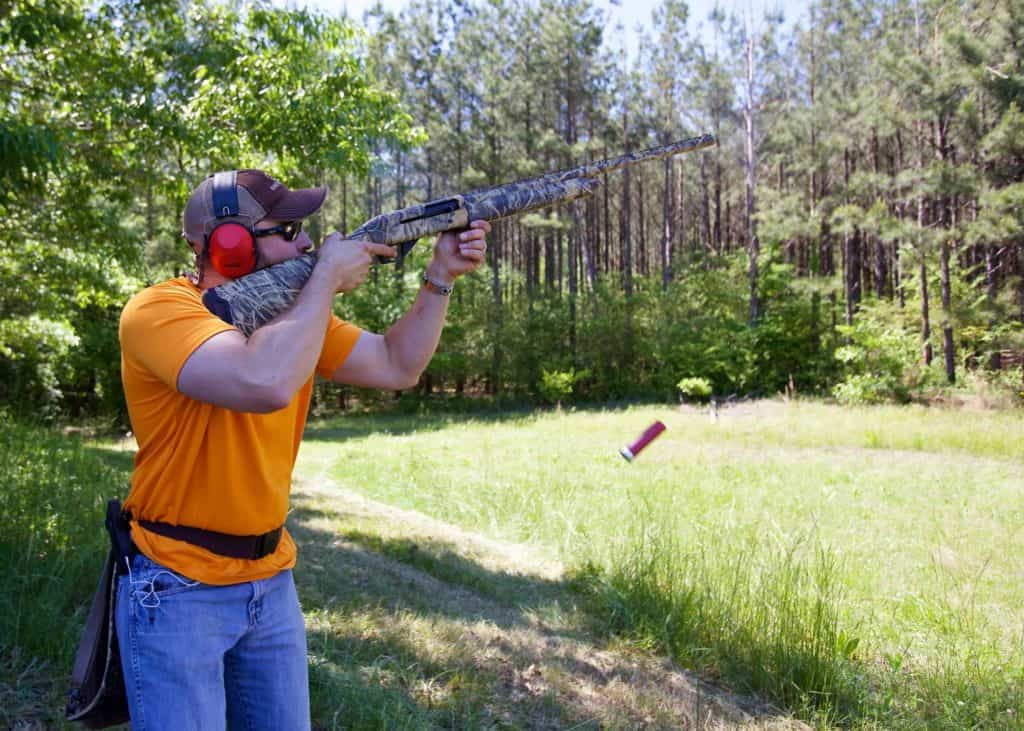There are different types of gun ranges and shooting clubs across the country. If you have never been to a shooting facility that has a sporting clay course. Then you should know before going what to expect. I did some research to find out how sporting clay scoring works and found out some cool information to help you get started.

Sporting clay’s is a shooting sport using shotguns to shoot down targets that are thrown into the air by a trap machine. Any type of shotgun can be used but some are more preferred. Shotgun types like double barrel side by side, over-under. Semi-auto or pump. The most common you see in sporting clay’s is double barrel.
So first what is a good score in sporting clay’s?
A good score for someone’s first time shooting clay’s would be 50%. This means the shooter has successfully shot down half of the targets used for that round.
Depending on the experience of the shooter and the difficulty of the course.
Pro-Tip: Always wear ear protection when shooting, even outdoors. If you are interested in comfortable ear protection.
Check out the best molded ear plugs for shooting on Amazon.
Sporting Clay Scoring
Good scores for sporting clay’s are relative to the difficulty of the round and the course. Most shooting clubs with sporting clay have two courses to choose from. One easy and one hard course. Easy courses are slower paced and the targets are closer to the shooter. Hard courses the targets are further out and more technical.
Shooters move from one station to the other until they have completed the course. Menus are designed to help shooters know how each station is setup. On some courses you are able to walk the course or can drive a cart and go from station to station. There is no maximum or minimum amount you are required to shot. If allowable you may be able to skip stations. Depending on how busy the shooting range may be.
There is a remote at each station that controls the trap for releasing the targets. One person handles the remote while the shooter is in position inside the station stand. The shooter calls out “pull” or “bird” when they are ready for the targets to be released.
A course can have any number of stations to shoot from. Each station will be setup differently by how many targets are used and how they are thrown. The number of targets used for a certain station is called pairs.
| Station Type: | # of Targets: |
| 3 – Pair Station | 6 |
| 4 – Pair Station | 8 |
| 5 – Pair Station | 10 |
Types of Pairs:
- Report Pairs: One Target (clay’s) released/thrown at a time.
- True Pair: Both targets (clay’s) released at the same time.
The remote is designated for each type of pair. There are three buttons on the remote, A-Bird, B-Bird and a pair button.
| Report Pair | When shooter says “pull” or “Bird” press A-Bird, Then upon the gun fire sound press B-Bird. |
| True Pair | When Shooter says “pull” or “Bird” press the pair button. This releases both targets at once. |
Remote capability can vary from course to course.
A typical sporting clay round will include 50-100 targets total. The number of stations is different for each course, some courses may have as many as 15 stations. Each one being unique and sets up a different setting and scenario.
The level of how technical a course is can be determined by several factors. The speed of the target, the elevation, angle and distance. The size of the targets can be different as well. The clay’s can be thrown and designed in ways to replicate the flight of birds.
Targets can be flown from many directions for each station. Some are flown towards the shooters some away.
There are even targets called “rabbit targets” that its released low to the ground. The rabbit target skips across the ground or even across ponds.
One exciting thing about the sport is that each course is unique and can be modified to keep challenging the shooters. The background of the course/station is a factor in how the trap is setup.
Sporting clay’s unlike the other disciplines is mean’t to replicate actual hunting of game birds. Even
Average Clay Shooting Score
Average is the term used for the percentage of clay’s (targets) the shooter has killed/hit during the round.
A average hunter or shooter practicing using sporting clay’s will score 35%- 45%. Meaning they hit that amount out of the total targets for that round. On a tougher course a lower average is to be expected.
How to Score Sporting Clay Round
On each station the targets will be thrown in pairs. The score is determined by how many targets are hit out of the pairs.
| Shooters Score: | Results: |
| Both Targets Broken | Dead Pair |
| Both Targets Missed | Lost Pair |
| First Target Broken, Second Missed | Dead & Lost |
| First Target Missed, Second Broken | Lost & Dead |
Dead is the term used for a target that has been hit (shot).
A target that is Lost means it was completely missed or just grazed. The score for that target is zero.
On the scorecard for each Dead/broken targets mark a “/” or “X”. For lost/missed targets mark a “O”
| Scorecard Mark: | Score Meaning: |
| /, X | Dead, Kill |
| O | Missed, Lost, Zero |
Add up the the total number of dead/broken targets for each station. Write the number on the designated spot on scorecard. At the end add up the the total and you will get your score.
Scorecards are different for each course but the markings are the same.
Professional Sporting Clay’s Associations
The biggest association that governs U.S. sporting clay sporting events is the NSCA (National Sporting Clay’s Association). They are behind the National Championship held every year.
How to Find A Sporting Clay Course Near You:
If you are looking for a club or shooting facility with a sporting clay course there is a great website. You can search or browse different gun clubs in your state. This site also shows which type of shooting sports the particular place has available.
Clay Targets Online is free to use: https://www.claytargetsonline.com/
Basic Sporting Clay Terminology
Broken: State of shotgun/firearm when not in use. Barrels are unlocked and chambers are empty of shells.
No-Target: When target is broken by the trap. Also called No-Bird can mean offense was committed by the shooter.
Single: One clay target/bird is thrown, or one clay is shot by the shooter.
Stand: The designated spot where shooter will shoot from.
Trap: Machine that releases the clay’s into the air.
What Shells to Use for Sporting Clay’s
Figuring out which ammo to use for your shotgun when going clay shooting is important. If you are new to shotguns it can be confusing.
The best shells to use are 12-20 gauge target or game load specific. Shot sizes no larger than 7.5, 8 or 9. Shot weight no heavier than 1 1/8 oz. Shell size 2 3/4 length or smaller.
- Gauge: 12-20.
- Shot Size: 7.5, 8 or 9.
- Shot Weight: 1 1/8 oz or lighter.
- Length: 2 3/4
Most clubs offering sporting clay will not allow 12 gauge loads to exceed 1 1/8 oz. Shot size can be 7.5, 8 or 9. Also a common rule is no 3 inch shells allowed.
So what does this all mean? Real simply I will explain the terms and the numbers will make more sense.
OZ. Shot: The total weight of the BB’s in the shell. (example: 1 1/8 oz)
Shot: The size of the BB’s in the shell. The larger the number the smaller the size of the BB. A size 7.5 shot will have more BB’s than a 9 shot. (example 7.5)
Length: What size chamber the shell can be used in. (example 2 3/4) The longer the length the more powerful the shot.
How Long Does Sporting Clay’s Take?
Times can vary for different experience level shooters and from course to course.
Typically 50 – 100 target round courses can be completed in less than 2 hours. This is with a steady pace and no breaks. 50 targets can be done in about a hour time span and 100 targets about 2 hours.
Check out the course’s website and they should mention under their FAQ how long it is expected to take. A common course length is 12 stations but there is no designated length that is followed. Unlike other sports there is no official rule on the number of stations and targets.
Only for competition matches is there a governing set of rules and regulations that must be followed.

